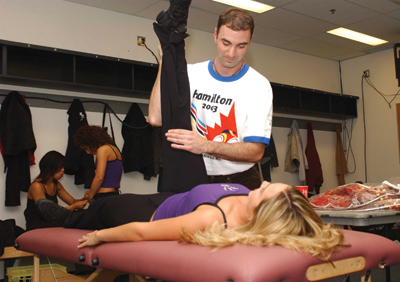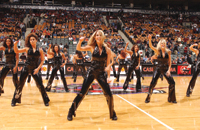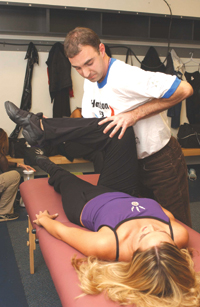
Features
Practice
Technique
Something To Cheer About!
I am a graduate of Sutherland Chan School and Teaching Clinic and The Shiatsu Academy of Tokyo. I have been working with the Toronto Raptors Dance Pak since 1999. All of the Dancers are professionally trained in Ballet, Jazz, Tap and Hip-Hop. Most have been dancing since the age of three and must be 19 years old to make the senior team.
September 23, 2009 By Mike Greene MT
I am a graduate of Sutherland Chan School and Teaching Clinic and The Shiatsu Academy of Tokyo. I have been working with the Toronto Raptors Dance Pak since 1999. All of the Dancers are professionally trained in Ballet, Jazz, Tap and Hip-Hop. Most have been dancing since the age of three and must be 19 years old to make the senior team. There are 17 members of the Dance Pak and rotations of 12 dancers perform at Toronto Raptors home games.
My duties as the Dance Pak’s team therapist include sports massage, athletic taping, and administration of hydrotherapy and first aid. Taping applications are used for inversion sprains or plantar fascitis.

|
|
|
I arrive at the Air Canada Centre 90 minutes to two hours before game time. Common injuries and conditions I see with dancers are Shin Splints, Muscle Strains, Sprains (ankle, knee, wrist), Spasm, Tendinitis, Plantar Fasciitis, Delayed On-set Muscle Soreness and general muscle fatigue.
I watch the dancers’ on-court rehearsal to look for any antalgic postures. If I see changes in their gait or movement, I will treat them as soon as possible before game time.
Most dancers have the mentality that a little pain is normal. Some will only mention a concern when the problem has gotten to the chronic state or when the pain is above their normal threshold, i.e. they present with lower back muscle spasms. They mention their back has been feeling tight all week and that they have been dancing through the pain.
Common postural imbalances are anterior rotation of the hip, unilateral elevation or depression of an ilium and either pes plantis or high arches leading to ankle, knee and hip pathologies. Hip pathologies can be caused from muscle imbalances such as tight rectus femoris or iliopsoas causing the anterior rotation or quadratus lumborum tightness or hamstring tightness causing a unilateral change in ilium levels. Where there is tightness in one area, there may be muscle weakness on the opposing side. This is commonly called a lower cross syndrome.
With limited time before a game, dancers with injuries are treated first. I then administer general pre-game warmup Sports massage and stretching. The techniques that I use in pre-game warmups are a combination of Sports Massage without oil or lotion, Shiatsu, Rhythmic Mobilizations, Rocking & Shaking, Joint Play, Strain-Counter Strain and Stretching. The aim of a warm-up massage is to stimulate the muscle tissue, increase local circulation, generally warm up and loosen the muscles and connective tissue.

|
|
|
|
A basic pre-event Sports Massage for the Lumbar to Middle Thorasic would involve the dancer lying prone and then using a rocking technique starting at the Iliolumbar spine L4-5 segment. Facing the left side of the dancer, your right hand would be on the right ilium and is pulling the ilium towards yourself while your left palm (working more thenar and hypothenar muscles of the hand) on the right erector spine group. Think of pushing the spinalis muscle away from the spine giving a stretch to the muscle and connective tissue. Both hands moving at the same time but having the right hand start a second sooner than the left to get the rocking motion going and continue the left hand up the erector spine group just below the scapula and continue back down again.
The technique is started slow and gradually increased in rate of speed and pressure and repeated a few times up and down the back. Simular motions and variations are applied to the rest of the body. Remember techniques are applied with the goal to stimulate, loosen and warm up musculature tissue. The entire body can be treated using the basic Sports massage technique in approximately five to seven minutes.
A technique I like is Shiatsu, using thumb pressure, for example, and stretching. The result is a Dynamic Myofascial stretch to the tissue. Pressure is held on the muscle where it feels restricted and tight. Place the muscle in a shorten position, applying gentle to moderate pressure and bringing the muscle/limb through
its full range of motion.
This technique may be painful to the dancer so I sometimes use a little lotion to decrease the fascia burning feeling that they may experience.
Stretching techniques I use are Active Isolated Stretches for a warm up stretch. The stretch is held for two seconds at the dancer’s comfortable, pain-free end range and repeated about 10 times. Post Isometric Relaxation (PIR) and (PNF) Post Neuromuscular Facilitation for shortened muscular and connective tissue showing a decrease in range of motion. PIR stretch is brought to the first end range or resistance felt by the therapist.
The dancer is instructed to contract the muscle being stretched at 10 per cent of their power for 10 seconds and repeat three to five times. Each time increasing the range of motion to a greater pain-free length.
PNF is similar to PIR but the dancer is told to contract the muscle being stretched at 80 per cent and can be done isometrically if the range of motion is limited or eccentrically to lengthen shorten muscle tissue.
When treating a dancer with an ongoing injury, it isn’t possible to fully rehabilitate the injury, but the focus is to have the dancer be able to perform their dance routine. For example, if a dancer is complaining of muscle soreness, tightness and showing decreased range of motion with muscle testing, I may not have time to loosen the tissue completely. I want them to be able to perform without extreme pain or discomfort. In this case I may perform a quick sports massage to increase circulation and do some general stretches to decrease tissue tightness and restore range of motion to a level they feel comfortable performing at.
If a dancer is injured and wants to perform, I will assess the injury to see if it is safe for her to dance first. I use ice to decrease inflammation and try to keep the injury stabilized. I will tell the dancers if I feel there is a chance of further injury and I inform the dance co-ordinator of this as well. The dance co-ordinator may suggest the dancer sit out certain routines. Most dancers have the mentality that “the show must go on.”

|
|
|
|
Taking themselves out of the lineup is a hard thing for the dancers to do. With the support of their co-ordinator and teammates, dancers look at the bigger picture of sitting out for a shorter time, instead of having a long-lasting or more serious injury. At this point a treatment plan is given to them and they are advised to get therapy ASAP to get themselves back into rehearsals.
I am very fortunate to have the opportunity to consult with the Toronto Raptors’ athletic therapist, chiropractor, sports physician, and massage therapist and have utilized their expertise in the treatment
of the dancers.
Scheduling regular maintenance treatments with the Dance Pak members is a challenge. Some of the dancers have numerous jobs. When they do come to my clinic I treat them with a recovery or maintenance goal massage. The treatment is slower with a bit more general Swedish massage to “flush out” waste products.
Dynamic myofascial techniques are used to release fascial tension around the muscles and joints causing better neural transmission, muscle relaxation and improve circulation to the tissue. I find myofascial techniques restore range of motion and decreases muscle imbalances quite quickly and is less physical work for me. Frictioning techniques are done during maintenance treatments to minimize the inflammation response too close to an event and potentially hindering their performance.
Many of these techniques were demonstrated and taught at this year’s Canadian Sports Massage conference in Toronto.
Print this page